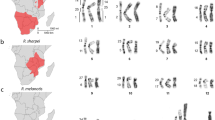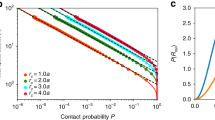Abstract
FROM an analysis of crossing-over in Drosophila melanogaster, I was led to certain conclusions concerning the distribution of the chiasmata, or points of exchange, along the cytological chromosomes1. In particular I noted that the centromere, or spindle attachment, showed certain peculiar relations to the regional frequency of crossing-over, and I advanced the hypothesis of a time sequence in the occurrence of chiasmata (moving away from the centromere) to account for these observations.
This is a preview of subscription content, access via your institution
Access options
Subscribe to this journal
Receive 51 print issues and online access
$199.00 per year
only $3.90 per issue
Buy this article
- Purchase on Springer Link
- Instant access to full article PDF
Prices may be subject to local taxes which are calculated during checkout
Similar content being viewed by others
References
Mather, K., J. Genet., 33, 207–35 (1936).
Charles, D. R., J. Genet., 36, 103–26 (1938).
Sturtevant, A. H., and Beadle, G. W., Genetics, 21, 554–604 (1936).
Author information
Authors and Affiliations
Rights and permissions
About this article
Cite this article
MATHER, K. Distribution of Crossing-Over in the Chromosomes of Drosophila. Nature 142, 157–158 (1938). https://doi.org/10.1038/142157a0
Issue Date:
DOI: https://doi.org/10.1038/142157a0
This article is cited by
-
Genetische Untersuchungen zur Chiasmabildung und Interferenzwirkung beiDrosophila
Zeitschrift für Induktive Abstammungs- und Vererbungslehre (1939)
-
Time Sequence of Crossing-Over
Nature (1938)
Comments
By submitting a comment you agree to abide by our Terms and Community Guidelines. If you find something abusive or that does not comply with our terms or guidelines please flag it as inappropriate.



